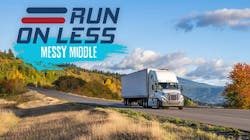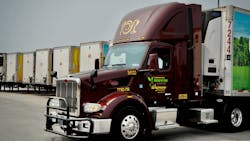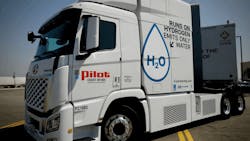Run on Less fleets discuss range, maintenance, infrastructure needs
Key Highlights
- NACFE's Run on Less — Messy Middle is ongoing, with the organization releasing video profiles on each participating company
- Three of the profiles are focusing on Wegmans, Pilot Travel Centers, and Saia Inc.'s use of compressed natural gas, hydrogen fuel cell, and battery-electric vehicles
- Chekc out maintenance tips for each powertrain type
The North American Council for Freight Efficiency (NACFE) is currently holding its 2025 Run on Less — Messy Middle event, in which selected fleets are demonstrating how alternative powertrains function in working environments. So far, NACFE has released three of 13 profiles on companies with trucks running on various powertrains, including renewable diesel, biodiesel, hydrogen fuel cell, and battery electric, with more to come while the event runs from September 8-26.
“Each fleet was unique, and we encourage you to review the profiles and watch all the videos to gain a better understanding of how fleets are making these powertrain solutions work today in their businesses,” said Mike Roeth, NACFE’s executive director.
The three profiles that have been released so far include Wegmans operation in Rochester, New York, which is exploring natural gas engines; Pilot Travel Centers’ work in Rialto, California, which is using hydrogen fuel cell power; and Saia’s operation in Stockton, California, which is using battery-electric trucks. For more details on how each fuel source has worked for each fleet and the maintenance associated with it, see below.
Wegmans natural gas trucks
Wegmans, a grocery delivery and logistics company, currently employs 197 natural gas trucks. More specifically, these are Peterbilt 567 day cabs with Cummins X15N 15L natural gas engines with Allison 4000 transmissions. The vehicles each have a 3.70 axle ratio, a 6x4 configuration, and roof and cab fairing and aerodynamic mirrors to reduce drag.
While Wegmans reported that early CNG tractors had problems with the response between the engine and transmission, which caused shifting issues, they’ve found much more success after consulting with Cummins.
“Now with the Cummins 12- and 15-liter and the Allison transmission, anything a diesel can do, we can do with this CNG truck,” said Matt Harris, procurement area manager at Wegmans, in the profile video.
Now, Wegmans has found it can do tandem work to its Erie and Boston locations as well, partially due to the extra power from the 15L engine. However, one thing the company needs to watch out for is heat, explained Lucas Cullen, GM of Metzger Gear. But he does credit the new 12L engine and the redesign of the 15L engine as better equipped to deal with the rising temperatures.
“Probably the key thing is there's a 75 [degree] C reduction in temperature of the top side of this engine, which adds to durability of things like cylinder heads, exhaust manifolds and turbos, but also heat rejection to the coolant,” said David Powers, fleet account executive with Cummins.
But Wegmans has also noted that it’s best to avoid idling with their CNG trucks.
“Every hour that these trucks run where you're not cooling the engine by driving down the road, it can be a really a problem for these CNG trucks,” Wegmans’ Harris explained. “It’s very important to keep idle time down, not only for health reasons for the tractor, but also for emissions reduction and noise reduction.”
More on maintaining CNG engines
While Wegmans didn’t bring it up in their profile, it’s equally important for fleets to consider an alt-powertrain truck’s maintenance needs as its capabilities. For compressed natural gas trucks, it helps that the engines are pretty similar to diesel ones.
“Both have an engine block, oil pan, lube system, and cooling system,” David King, product manager for natural and renewable gas engines at Cummins, told Fleet Maintenance in April. “But when you get to the cylinder head, the design is specific to the fuel type. There are unique cooling passages on a natural gas engine to keep the head and spark plugs cool. Speaking of which, sparkplugs and ignition coils replace the diesel fuel injectors since natural gas is a spark-ignited fuel.”
CNG engines have a similar ECM, albeit with unique software, as well as a spark and fuel-injection control model. They also tend to have an EGR, as well a three-way catalyst. But CNG engines do lack aftertreatment system items such as DPF, a hydrocarbon doser, SCR, or DEF.
Knowing this differences in engines, technicians need to maintain the spark plugs on a natural gas engine. They also need to carefully inspect these engines, with the National Highway Traffic Safety Administration requiring that any vehicle over 10,000 lbs. must go through a 12-month inspection, including checking fuel lines and cylinders.
“We use a depth gauge to look for abrasions in the resin,” said Javier Gonzalez, service director for Rush Truck Centers’ Peterbilt dealerships. “There is a specification set by ANSI and the NFPA (National Fire Protection Association) that includes inspection requirements associated with nicks, gouges, and abrasions. You can’t just rely on eyesight. And if a label is ever missing from a cylinder and you can’t verify the manufacturer, it must be taken off the vehicle and decommissioned.”
Pilot’s hydrogen fuel cell trucks
Meanwhile, for Pilot, the company runs five Hyundai XCIENT hydrogen fuel cell trucks. Each one features a 350 kW e-motor and a 72 kW/hr battery back and a ATM S4500 Allison transmission. According to the company, they’ve been running their hydrogen fuel cell trucks for almost a year.
“They’ve got plenty of torque, they get up to speed,” noted Bill Zobel, sr. director of hydrogen and infrastructure at Pilot Travel Centers. “I haven't had any issues with performance at all, and they're quiet.”
Another benefit to the trucks is that they work well for long-haul operations and have a large range, which works for Pilot since they run their trucks 24/7, said Bradley Cooper, sr. manager, Logistics – Specialty Products for Pilot.
According to Hyundai GM for Commercial Vehicles and Hydrogen Benjamin Happek, the company has seen a wide driving range of 430-510 miles, depending on various factors. For Pilot Dave Bickmeier, lead driver and trainer for Pilot, that wide range has let him maximize his miles per kilogram of hydrogen over time.
“Originally, when I first started driving a hydrogen truck, my average mileage per kilogram was about 5.9, which is not great, but I learned how to drive it,” Bickmeier said. “I just drove it yesterday, [and] I was at 9.1 miles per kilogram.”
Additionally, Service Manager Eric Adamson at Tom’s Truck Center, a Pilot dealership, noted that the FCEV made it easier to access certain components and that they’ve built a specialized hydrogen bay for their dealership.
So far, the biggest difficulty has been establishing refill points, since there’s “no commodity market for hydrogen” Happek commented. This means fleets need to work with industrial gas companies to figure out exactly what they need before negotiating pricing on their own, which currently drives up costs.
More on maintaining FCEVs
When driving FCEVs, there are a couple inspection differences when handling pre-trip checks. For instance, Bill Hall, founder and managing member of Coyote Container, found that his Nikola Tre FCEVs required cooling tank checks instead of engine oil level checks before hitting the road.
Additionally, he noted that drivers should check for any coolant leaks or issues with the fuel cell, wiring, or tubing. He also cautioned that some of his tires were wearing faster and developing heat-affected splits. This could partially be because FCEV frames are heavier and the drive axles have a lot of torque, meaning drivers need to keep an eye on tire pressure, just as they would for a diesel truck.
Saia’s Tesla Semis
Of LTL fleet Saia’s 7,000 tractors, the company currently has two electric Tesla Semi trucks in their fleet. The trucks are day cabs with three electric motors, a 3.70 axle ratio, and various aerodynamic devices such as high roof fairing, aerodynamic cab-mounted mirrors, and aero skirts. Generally speaking, the company reported that their semis had a range of about 500 miles.
For Saia, the Semis have tended to work best in metropolitan environments, but this doesn’t mean they can’t operate line-haul routes, either.
“In some instances, tractors definitely do pull double duty, as we say,” said Ryan Madura, sr. project manager for Saia. “So they'll run a line haul run at night, come in, and then they'll go right back out for a [pickup and delivery] city run in the morning. One of the Tesla tractors is actually doing that right now.”
Part of the reason the Tesla Semi can work well for urban runs is that it’s very maneuverable. Michael Davis, a driver for Saia, said that “It has a better turning radius than our two-axles.”
Additionally, driver Tom Sterba reported that “the navigation systems in these in these trucks are just unbelievable,” as are the clarity of the cameras.
But for all their praise, Davis did acknowledge that the 500-mile range tends to drop quickly when driving in real-world conditions.
“Just use your cruise control and try to stay steady,” he advised. “If you stay away from everybody and you’re not constantly giving [the truck] gas, it’s fine. You get as much as you can out of it.”
Saia has also fine-tuned how they manage their charging for the trucks depending on their duty cycles.
“It takes probably 45 minutes to go from 5% to 75% or 80% [battery],” Madura reported. “We're able to limit the amount of charge [their city tractor] can get. So, we limit it at 80% [because] we found that that makes the best use of the time charging versus the time on the road. So he charges maybe once or twice a week. Once he gets up to the 80%, they don't need to go charge again for a week in the city.”
More on maintaining battery-electric trucks
One great benefit of servicing battery-electric vehicles is that with fewer moving parts, there tends to be less internal wear due to heat and vibration. Additionally, regenerative braking tends to decrease wear on friction brakes, too, also decreasing maintenance there.
However, as a trade-off, BEVs do tend to have more software and computer hardware than diesel-powered vehicles. While downtime due to needed software updates may not be as costly as other component failures, fleets should still consider the loss of time on the road when a tech is troubleshooting software problems. This same awareness should apply to sensors, as well, since BEVs tend to have more sensors onboard that can send incorrect signals or none at all, both of which would need to be fixed.
For hardware that techs need to keep an eye on, an EV’s heavier frame may mean that fleets need to replace an EV’s tires more often, and that they need to watch their tire pressure more closely.
Additionally, due to an EV’s large battery, it’s critical to check the battery coolant level regularly.
About the Author

Alex Keenan
Alex Keenan is an Associate Editor for Fleet Maintenance magazine. She has written on a variety of topics for the past several years and recently joined the transportation industry, reviewing content covering technician challenges and breaking industry news. She holds a bachelor's degree in English from Colorado State University in Fort Collins, Colorado.



